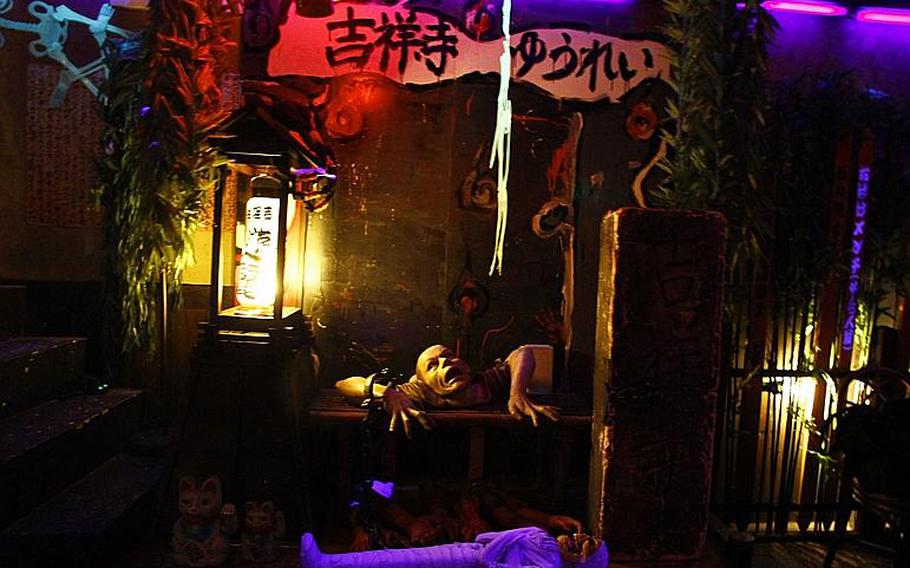Living
AFTER HOURS: JAPANAfter Hours: Yurei-themed restaurant in Kichijoji, Japan
Stars and Stripes September 27, 2013

Would you like a side order of hellscape with that beer? You can at Yurei. (Wyatt Olson/Stars and Stripes)
Every culture has its own special way of sending off the deceased to the next world. And every culture, it seems, has its lore about those among the dearly departed who refuse to go away completely: ghosts.
In Japan, the spirits of souls who have died but remain or return are called “yurei.” They have a number of reasons for lingering among the living. Some seek revenge. Mothers who died and left small children behind might return to bring them treats. Children at times return as mischievous pranksters. Samurai ghosts who fell in battle can’t give up the fight. And there are succubi.
These many varieties of yurei are also the namesake of a busy little basement restaurant in Kichijoji, but the only genuine spirit you’re likely to encounter there is fun. It’s an izakaya-style restaurant — the kind of place where beer and sake are as important as any food — but with a haunted theme.
You’ll know you’ve found the right place when you approach the entryway at street level and hear an eerie moaning wafting through the air.
Descending the darkened stairwell, lit only by flickering electric candles, we couldn’t see what was ahead when we visited on a recent Sunday evening. When we opened the door, a smiling waitress waited, dressed in a traditional Japanese white burial kimono.
That white garb is one of the characteristics that makes ghosts immediately and universally identifiable in Japan. The other ghostly identifiers are long, messy black hair; dangling, lifeless hands; and flickering auras of light floating about them. Our waitress lacked these three additional attributes, so we figured she was among the living and followed her to our seats at the L-shaped bar.
The place is dimly lit, decorated with figures of goblins, creatures and skeletons illuminated by black light.
Fog machines periodically fill the air with a haze.
The music from the sound system varies widely, but nothing that could really be described as spectral — unless the theme from “The Munsters” is your idea of spine-tingling.
The menu isn’t in English, but the waitresses are game to help non-Japanese speakers. They have a couple of English “cue cards” written with a short explanation of the restaurant.
“This is Johnson,” the waitress said, clapping her hands loudly. A plate-sized black mechanical spider fell in front of our faces from above the bar. The attached string then slowly lifted him back to the blackened ceiling.
Lying on the bar in front of us was a human arm, severed bloodily at the forearm. The plastic arm is used to beckon a waitress to place an order.
We asked ours to choose a few of the most interesting items not to exceed $30 total, including a couple beers.
Left for a future visit were two items whose names loosely translate to “Oh death light I advance” and “Curse of the turtle.”
We soon had a plate with two human-like figures skewered with a voodoo wood stake — deep-fried hotdogs breaded to give them arms, legs and a head. Their bellies were covered with “blood,” or, as it’s more commonly known, ketchup.
Next up was an item whose meaning had us baffled until a few days later when a Japanese friend explained it: a mound of potato salad with shoestring potatoes jutting out of it like a porcupine.
This represented “Hell Hill,” a mound of spikes that must be crossed by anyone condemned to a hellish afterlife in Japanese folklore. In this case, it was yummy.
The show-stopper, though, was our “cremation spareribs.” The meaty ribs were doused with the Japanese distilled liquor shochu and then set afire. The flames leaped up a yard, almost scorching Johnson’s eight legs above.
As a special unexpected visual treat, a table nearby was celebrating a birthday and was served ice cream and brain — although the latter, with a large candle stuck in the middle of it, wasn’t edible.
It was simply one of those little touches that makes Yurei an otherworldly experience.